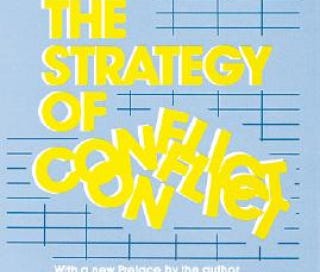To the degree that Rationalists have bibles, this book is one of them. The Strategy of Conflict is a book whose main objective seems to be laying the grounds for a theory of rational decision-making and negotiation. It takes as its starting point the classical formulations of Game Theory from the likes of John Nash, but tries the move the field to a more pragmatical, utilitarian and less purely mathematical formulation, where games are not necessarily zero-sum, pay-offs are not symmetrical and players can have differing degrees of rationality. It is easy to see where this would come in handy: any for of real life negotiation and/or conflict can be modeled upon this. Schelling’s specific interest seems to have stemmed from Cold War deterrence and how to collaborate with a rival (in this case, the Soviet Union) you can’t really trust, and who can’t really trust you either, and how to avoid ending up in prisoner’s dilemma situations with a worse outcome for both players. The book has a really strong sixties-Cold War vibe.
It is also easy to see why Rationalists go crazy about this stuff. It is nerdy. It is mathy. It was written by a Nobel-prize winner in Economics. It is applied to practical purposes, and promises to be a sort of all-encompassing science of winning at decision-making and conflict resolution (little ad hominem note here, but nerds can’t resist loving the promise of defeating the bullies who are either stronger and/or more socially savvy than them with the power of intelligence and rational thought). In retrospect, I can see how this book was everywhere in the background of Yudkowsky’s HPMOR, and of many of the arguments present in digital spaces like Less Wrong or the EA Forum.
The book has many things of interest, but if I had to pinpoint a couple as valuable insights to retain, it would be these:
Focal points: even in the absence of negotiation and agreement, it is possible for opposing sides to agree on some ‘natural’ (contextual, cultural and expectation-based) equilibrium point for reaching a relatively balanced and accepted boundary or solution in a conflict (where ‘conflict’, all through the book, is being used in a general sense of two or more players in a situation who might not have identical incentives and pay-offs for a given situation).
Rather counter-intuitively, in a way that makes one thing of typical Zen or The Art of War sayings, sometimes less freedom is actually a good thing, and a useful strategy for winning. This is the idea behind things like nuclear deterrence through some Doomsday Machine - not being free not to use it actually strengthens your negotiation position, as your adversary is forced to acknowledge that you aren’t bluffing and will carry out a thread even if it is clearly to your own disadvantage after deterrence has failed. This actually makes the deterrence more effective.
I was a bit conflicted when having to decide what score to give it. On the one hand, the book is interesting and valuable in what it says, but I feel it is mostly useful for contexts and people who are not me (in a sense, we can all profit from being able to strategize more effectively in all types of situations, but the book can’t really provide you will some clear rules to follow: most of it comes down to ‘reality is really complex and unpredictable, you can only try to guess other’s people’s utility functions, so these are problems that are not amenable to some simple, mathematical solution’. In which case, a lot of the mathematical apparatus the book presents feels unnecessary, as just a refinement of what people already do without it in guessing, from context and previous knowledge, how someone is going to behave. Perhaps it comes more to fruition in contexts where decisions are really important and high-stakes. Rationalists know and quote this book backwards and forwards, but from a superficial, outsider perspective, it doesn’t seem to have led to them being so much better than average at successful decision-making and strategizing (they/we still being, mostly, a bunch of socially clueless and clumsy nerds). The book is also a bit dull (this wasn’t helped by me using it as my 50-minute daily treadmill read; lighter books are more appropriate for that context). I’d give it three different ratings, in fact: its entertainment value is 1, its global usefulness and intellectual relevance, probably a 5. In the preface of the edition I’ve read, the author laments how the high expectations for his new type of ‘socially applied game theory’ haven’t seemed to have come to fruition, and I also feel this is at least partly correct.




